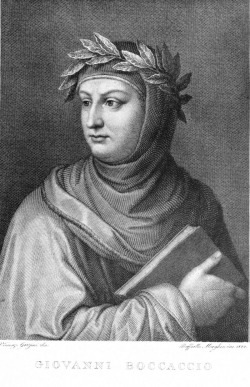Biography.

Giovanni Boccaccio (June 16 1313- December 21 1375). He was a Florentine author and poet. The exact details of his birth are unknown. He was a son of a Florentine banker and a Parisien mother. His place of birth is likely to have been in Tuscany perhaps in Certaldo, his fathers town.
Boccaccio grew up in Flourence and his father was working for the Campagnia dei Bardi. In the 1320s, married Margherita del Mardoli.
People believe that Boccaccio was tutored by Giovanni Mazzuoli. In 1327 Boccaccio moved to Naples when his father was appointed to head the Neopolitan branch of his bank. Boccaccio persuaded his father to let him study law in the Studium in the city. Boccaccio had become a friend of fellow-Florentine Nicola Acciaiuoli and benefitted from his influence as lover of Catherine of Valois and later counsellor to Queen Joanna and the "Grand Seneschal".
Boccaccio spent six years being apprenticed to the bank but he enjoyed more the law. In 1330s Boccaccio became a father of two illegitimate childs, Mario and Giulio.
Boccaccio begun a poetri in Naples. Some of his work produced includes Filostrato, Tesada, Filocoio and La caccia di Diana.
The "Corbaccio" has had its admirers but is one of the most bitter and indecent satires ever written against woman and the "Vita di Dante" based chiefly on information furnished by contemporaries of DanteBoccaccio shares with Petrarch the honor of being the earliest humanist.
Boccaccio had to support at his house for three years a teacher of Greek. Boccaccio's Latin works the following are to be mentioned: "De genealogiis deorum gentilium" but published first in 1373. Two of his biographical works are: "De claris mulieribus" and "De casibus virorum illustrium" are of little interest since they tell of men and women of ancient times and but rarely of the author's contemporaries.
The book the "Decameron" was finished in 1353, but part of which had probably been written before the "Black Death" reached its height in 1348. The "Decameron" opens a description of the terrors of the pest. At all events, he says that he has taken pains to conceal the real names of the persons mentioned in the stories, there are reasons to believe that Fiammetta is the same lady to whom Boccaccio has given that name.
Of Boccaccio's later works the moralistic biographies gathered as De casibus virorum illustrium and De mulieribus claris were most significant. Some other inof his works include a dictionary of geographical allusions in classical literature, De montibus, silvis, fontibus, lacubus, fluminibus, stagnis seu paludibus et de nominibus maris liber. He gave a series of lectures on Dante at the Santo Stefano church in 1373 and these resulted in his final major work, the detailed Eposizioni sopra la Comedia di Dante. Boccaccios final years were troubled by illnesses, relationated with his obesiti and then he died in Certaldo.
http://en.wikipedia.org/wiki/Giovanni_Boccaccio
http://www.poemhunter.com/giovanni-boccaccio/biography/
http://www.historyguide.org/ancient/boccaccio.html
http://images.google.com/imgres?imgurl=http://www.gutenberg.org/files/22574/22574-h/images/illo047.jpg&imgrefurl=http://www.gutenberg.org/files/22574/22574-h/22574-h.htm&h=1239&w=800&sz=351&hl=en&start=28&um=1&usg=__813vceHhDWy-9bzPzDJfoPC5sAg=&tbnid=Ceo0jD88O5k4wM:&tbnh=150&tbnw=97&prev=/images%3Fq%3Dboccaccio%26start%3D20%26ndsp%3D20%26um%3D1%26hl%3Den%26sa%3DN
